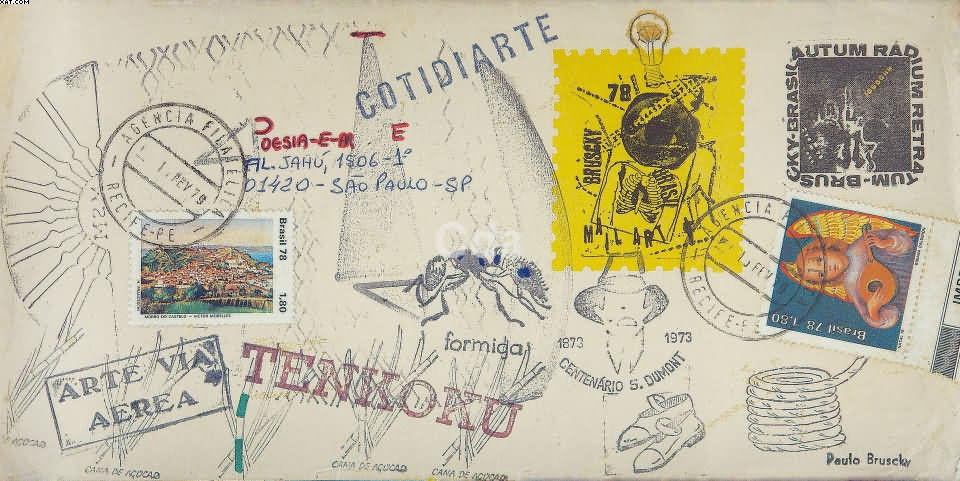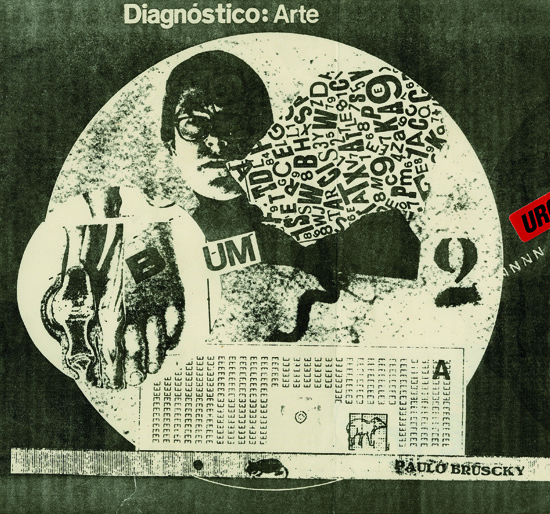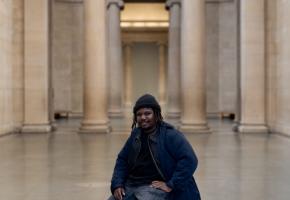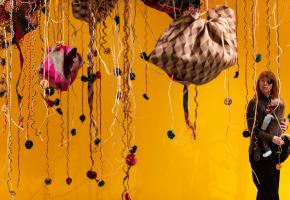Born in Recife (Pernambuco, Brazil) in 1949, into a creative family, and associated for years with the Fluxus and Gutai groups, Paolo Bruscky has been a passionate and creative pioneer in Brazil of MAIL ART. With refreshing humour, visual and literary poetry, collage, typography, word play, performance, sculpture, installations, objects and video to name a few, multimedia artist Bruscky has expressed and explored a myriad of radical ideas, challenging the political and cultural status quo and the role of media in art. Bruscky relished the considerable logistic challenge he faced, because, according to him, the postal system in Brazil is probably “the worst of anywhere in the world.”
This exhibition has a broad selection of some of Bruscky’s Xerox works, faxes, collages and videos, and among them the charming and very funny potion called: Remèdio Brusckyano (Bruscky’s Remedy 2015) designed to cure “infections caused by lack of imagination, intelligence and creativity.” Bruscky also includes a Xerofilm- Aépta (1982) a Xerox- animation storyboard, playing with Xerox images of a piece of string. There is a subtle richness to the ideas and the works, be they faxes, Xerox mono-prints or collages, often including the use of gentle wordplays that are truly refreshing and stimulating. A lively exhibition of a creative mind.
Largely self- educated, Bruscky believes that all artists are political by definition. “My art is conceptual, so naturally I will reflect the politics of the country I live in.” He was also brought up during a dark time in Brazilian history, so it comes as no surprise that, during the 1960’s and 70’s Brazil’s Military Dictatorship, his work was considered dangerous and he was incarcerated for his radical and left-wing beliefs. In those days, any gathering of 4 or even 5 people would be considered illegal, but Bruscky wanted people to pause and reflect when they came across an artist working in the street, as it obliged them to stop and think a little about their lives.
“If you make an urban intervention and work in the street- you open up people to thinking and that is not in the interest of any governmental body. All governments want the population to be as uninformed and ignorant as possible … as that is always better for them!”

It became clear that Bruscky’s Street Art and Happenings were not appreciated when he discovered that he was on an assassination list: -
“I had to go into hiding for a while. I hid for 2 months. But I feel that if you fight for your country, then you have to remain within it, so I never contemplated exile, and decided to hand myself in… I was tortured, physically and mentally, and threatened with death if I did not confess to things that were untrue. Members of my family were also threatened. It was a terrible time and therefore I am concerned with what is happening right now, [in Brazil], not for me, but for future generations… My father used to say when I was a child: the day that you are afraid you must leave your home and never return, because he already knew my political inclinations. But I’ve never been afraid. One day I will have to die, but if it were for a just cause, I would be happy.”
You may well ask what MAIL ART is exactly? It is a populist artistic movement that arose in the 1960s and 70s, and is also known as ‘Postal Art’, or ‘Correspondence Art’ and it focusses on sending small scale works by post. Media commonly used includes postcards, ‘artistamps’ (created by themselves), with rubber stamps, illustrations, collage, typography, and might even include music, poetry or sound art… anything that could be placed in/on an envelope and posted. There is a lot of word play, and the envelopes themselves are of great importance: ‘Envelopoema’.
Initially associated with Ray Johnson, Mail Art was then largely disseminated by the FLUXUS group founded by Georges Maciunas and influenced by artists like Marcel Duchamp. The ideas attracted artists from all over the world and they began to develop associations and exchanges, even with musicians such as John Cage, who sympathised with the principles behind the group. The group grew initially from a strong base in New York, and Maciunas himself described it as “A fusion of Spike Jones, gags, games, Vaudeville, Cage & Duchamp”. Today it has become a truly global phenomenon, with a number of famous people associated with it, including Banksy, Ai Wei Wei, Diane Arbus, Edgardo Antonio Vigo and Laurie Anderson. Maciunas suggested having a manifesto but everyone disagreed as it went against the most basic premise of their ideas.

Irreverent and challenging, these artists disagree with the authority of museums to determine the value of art, nor do they believe that you need to be highly educated to understand it. They believe that art should be available to all. Bruscky is very clear about this: -
“For me Art and Life are inseparable… you cannot disassociate one from the other.”
So, free and unfettered, it resulted in a form of ‘Intermedia’, with Concept Art, Video Art, and other forms. As John Cage expressed it: here was a notion that the artist should embark on an artwork without a conception of its end, so that the work was a site of interaction between the artist and the audience.
Nevertheless, there is a strong undercurrent of anti- commercialism and anti-art, therefore this new exhibition has been aptly named: -“Paolo Bruscky: The GALLERY WILL BE FUMIGATED OF ART”
One key characteristic of Mail Art and Fluxus, is the use of ‘HUMOUR’. Perhaps with Dada, this is one of the very few Art movements that have used play and humour as an integral part of their philosophy: with his very mischievous smile, Bruscky describes his work: -
“Humour is always present in my life and my work, especially irony. I was a journalist and studied a lot of semiotics, (the study of signs & symbols). Many of my works have words I have invented… when you live under repressive regimes you have to be clever to be able to express your ideas…”
This long artistic journey that Bruscky has been on, started when he was very young and took one of his first jobs in a hospital as a cleaner. Fortunately, when they realized he was an artist, they sent him to work in administration: -
“There I discovered the Xerox machine and started playing with it. I was very quick to complete my daily duties and would spend the rest of the day working on my ideas using the available technology, like the Xerox and the fax… I find the Fax is a great evolutionary invention.
It was already predicted by Jules Verne in one of his books, because it meant ‘transmission’… the de-materialization followed by a re-materialization at the point of receipt, which can be anywhere in the world! As the philosopher Walter Benjamin said “Technology is not the mastery of nature, but of the relation between nature and humanity… it aims rather at an interplay between nature and humanity.”

Bruscky carried out a project called “Work of many Heads” (Obra de Varias Cabeças) that travelled by fax simultaneously from Recife to nine different cities in the world, and when it was over, 24 hours of faxes were exhibited all over the world.
However, contact between the Mail Art artists can throw up anomalies and fascinating contradictions. When Bruscky and Robert Rehfeldt finally met after having had copious Mail Art Exchanges from East Berlin to Recife for many years they had much to surprise them.
As Rehfeldt pointed out: “We have corresponded for around 10 years. We have similar work ethics and motivations. You were a prisoner in your country because you were considered a communist and I was imprisoned in my country because I was considered a democrat.”
This long-term exchange between two artists living under politically oppressive regimes led to an exhibition called ‘HOME ARCHIVES’, that included their postal exchanges, urban and Xerox performances and even some X-rays of Bruscky’s skull. Bruscky’s interest in machines can be extensive and there were clearly a number of advantages to working in a hospital!
Despite producing a substantial body of work, Bruscky sold his first work only 10 years ago. He was too busy working to find time to get involved in the commercial aspects. So, he managed to survive working in administration and educated his children without selling any works at all. The result is that he has amassed a vast body of work that has yet to be properly catalogued. An eye watering prospect as Bruscky does not stop working for a moment, having already produced a number of items, objects and ideas in the very few days that he has been in London for the exhibition.
“Art is our last hope in the world of today, if it were not for Art our humanity would be lost, everything would get worse… the pendulum is going back to the Cold War… I have seen it all before.”
‘PAOLO BRUSCKY: The Gallery will be fumigated of art.’ runs till May 26th 2018 @ Richard Saltoun Gallery, 41 Dover Street, London W1S 4NS T.020 7637 1225



















